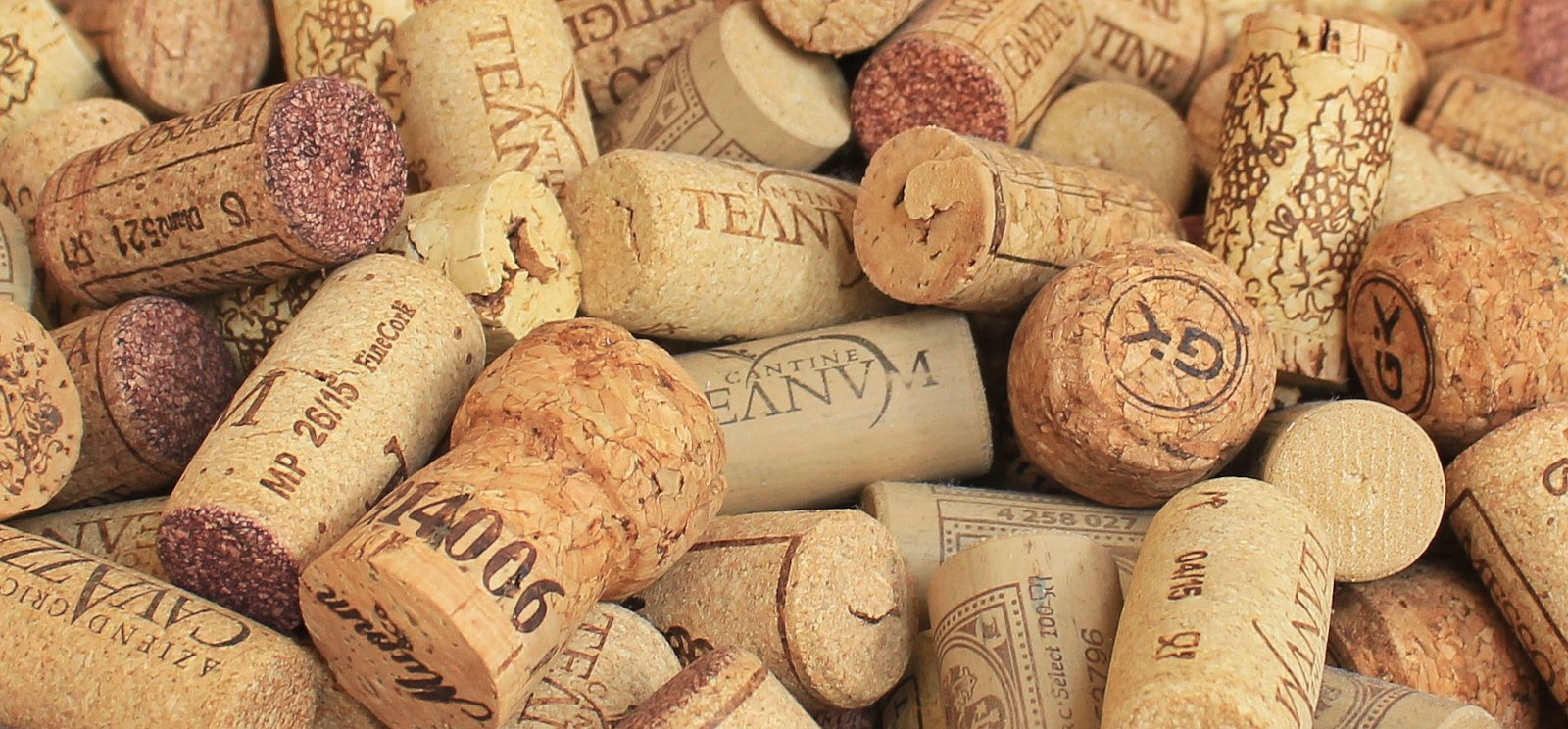We like to say no to Diam
Wine merchant finds scientific proof for the lack of sensory neutrality of Diam press corks
26 December 2020
Werner Elflein
 Photo: Pixabay
Photo: Pixabay“Diam is the only cork closure that provides both perfect homogeneity between one bottle and another and perfect control over the different levels of permeability. Through the DIAMANT® process, it also ensures incomparable sensorial neutrality.”
Rolf Cordes is a wine merchant from Mühldorf am Inn. In numerous tastings, he repeatedly observed the negative influence of the pressed corks of the southern French manufacturer Diam Bouchage on the taste of the wine. Since then, he has repeatedly questioned the sensory neutrality promised by the manufacturer.
In the past 20 years, various closure alternatives have established themselves on the market in addition to the traditional natural cork punched from cork plates: the screw cap, the plastic stopper and the pressed cork glued together from shredded cork residues. While it hardly matters to ordinary drinkers which of these closures is used, the demand for a sensory neutral closure is of great importance to passionate wine lovers who value unadulterated wine enjoyment. For wine producers, too, the decision for a bottle closure is an important and sometimes delicate issue.
 Photo: Rolf Cordes
Photo: Rolf CordesGood natural corks have always been expensive. A high-quality cork stopper costs well more than one Euro. Early pressed corks and plastic stoppers, however, proved to be consistently unreliable and inferior. Supermarkets and discounters then turned to cheap natural corks even for the simplest wines. “The quality of traditional natural corks declined significantly as a result,” says Rolf Cordes. The wine merchant, who has been working in the business for 26 years, estimates that the musty, dull smell and taste of the so-called cork taint appeared in 20 percent of all bottles sealed with natural and pressed corks around the turn of the millennium – an order of magnitude that we at weinfreaks.de can confirm based on our own observations.
Trichloroanisole – the main cause of cork taint
The main cause of the change in smell and taste in wine is the chemical compound 2,4,6-trichloroanisole, abbreviated TCA. Already from a concentration of one to ten nanogrammes, i. e. one billionth of a gramme per litre, the smell of TCA can be perceived. Lake Chiemsee, with a capacity of two trillion litres of water, would already begin to “cork” at a concentration of two kilogrammes of TCA. The devastating effect of TCA has already been felt by almost all winegrowers and wine drinkers.
Thanks to stronger quality controls and new techniques in cork production, cork taint has become rarer in the meantime, but it is far from being eliminated.
Sensory neutrality?
In 2004, Diam Bouchage introduced the Diam cork stopper to the market and at the same time proclaimed that it had found the solution to the wine industry's biggest problem, cork taint. To produce the Diam cork, cork residues are shredded and the high-quality cork component suberin, whose share in the raw cork is about 40 per cent, is separated from the remaining components. The suberin granulate is cleaned of TCA and other odorous substances using supercritical carbon dioxide and then glued together with synthetic material. The Diam thus consists of about 85 percent suberin and 15 percent synthetic material. To this day, Diam Bouchage guarantees the sensory neutrality of its pressed corks to winegrowers.
… sensory neutrality?
Packaging and closures are considered sensory neutral if they do not influence tastes, odours and senses associated with tactile stimuli (e. g. pungency or astringency).
As early as 2010, Rolf Cordes observed a flavour in the wine that he repeatedly associated with the Diam: “Unpleasant, rough and drying on the palate and in the oesophagus.”
Together with the oenologist and consultant Volker Schneider, he conducted various test series for the first time in 2015, the results of which were unequivocal. The general director of Diam Bouchage, Dominique Tourneix, reacted promptly to the first publication of these results and sent three employees to Mühldorf two days later to learn more about the test procedures used. Rolf Cordes pointed out to them in detail that the changes caused by the Diam were not a short-term bitter taste but a longer-lasting irritation of the oral mucous membranes. The subsequent tasting of wines without the influence of the Diam intensified the irritation and also affected these wines to the same extent. Cordes explained that the usual test methods such as the triangle test and the pairwise comparison were therefore not applicable due to the changing order of the wines.
… the triangle test?
The triangle test is a worldwide common method for sensory testing. In it, the test subjects are given three randomly numbered samples. Two are identical, one is different. The testers now have to find out which of the three samples deviates. The test is not applicable for substances that have an intense and lingering effect on the palate or in the throat.
Dominique Tourneix commented on Cordes' accusations in an interview by the wine portal Wein-Plus. He claimed that an article in the wine trade magazine Revue des Oenologues (No. 120, July 2006) would confirm the sensory neutrality. Upon reading the corresponding article, however, it quickly became clear to Rolf Cordes: Diam Bouchage was primarily concerned with the TCA in the measurements. From the reduction of TCA and 150 other odour-active substances, the manufacturer deduced the sensory neutrality of its pressed corks. However, the report in the Revue des Oenologues misses the point by far. The changes in taste and touch caused by taste-active substances criticised by Cordes are not refuted in the article. On the contrary: a diagram of the study even shows that the material the Diam is made of actually enhances certain odour notes. Sensory neutrality looks different.
The search for the cause
Renowned scientists and analysts took over the complex analytical search for flavour-altering substances for Rolf Cordes. Among them was Dr Wolfgang Schwack, former head of the department of food chemistry and analytical chemistry at the University of Hohenheim. Schwack conducted a sensory analysis of comparison samples with five students. The scientist's results confirmed the wine merchant's observations: “While the natural cork samples were overall sensory inconspicuous, all Diam samples produced a strongly masking and furry feeling in the mouth with a short delay. This sensory sensation lasts up to several hours and affects all subsequent wines and their testing. Ergo, a reverse tasting order is impossible, as is the triangle test to pick out the deviant sample.”
Dr Andrea Bauer, Professor of Sensory Analysis and Product Development at the University of Applied Sciences in Hamburg, confirms her colleague's assessment and, when asked, tells Cordes about an alternative test procedure, the A-not-A test. Cordes already used this test for his test series in 2015.
… the A-not-A test?
In the A-not-A test, the taster first memorises the taste and sensations of the reference wine. Then he tastes the second sample and compares it sensory with the first. The tester then decides whether the second wine is identical to the reference wine.
After the sensory test, Dr Schwack had natural cork and Diam discs soaked overnight in ten percent alcohol and measured using the liquid chromatography-mass spectrometry (LC-MS) method. Schwack's result: “A differential analysis initially showed more than 40 substances that occur significantly elevated in the Diam cork.”
Suberic acid was also detected during the measurements. It is a component of suberin in Diam. In order to check whether the suberic acid present has a taste-changing effect, Rolf Cordes added pure suberic acid to perfect wines. In the first series of tests, he started with a concentration of 1400 nanogrammes per litre and then lowered the content further and further. For Rolf Cordes and the testers, even the lowest values were still recognisable and the known changes were clear.
But Cordes wanted to know even more precisely and specified the tests. In September 2018, he let Dr Paul Haase-Aschoff's laboratory check whether and in what quantity suberic acid is transferred from the front of the Diam closures – i. e. the part that comes into contact with the wine – into alcoholic solution. Suberic acid was measured using a complex analytical procedure. In all samples, the concentration was between 1300 and 2200 ng/l. These are very low values. However, the perception of even lower concentrations of the cork defect causer, TCA, shows how sensitively wine reacts to foreign substances.
By scientific standards, the influence of suberic acid on wine taste was still not proven. Cordes therefore sent a number of comparison samples to the Department of Crop Sciences at the Georg August University in Göttingen. There, the samples were analysed with the sensor and software-based “electronic tongue” Astree.
… the electronic tongue Astree?
The beverage, food and pharmaceutical industries use the electronic tongue to test the taste and sensations of their products and the influence of closures on the contents. Plagiarism in the olive oil, wine and spirits sector can be unmasked with it.
The results yielded an unmistakable sensory fingerprint. Cordes describes the result as follows: “Suberic acid has a taste-changing effect in the concentration emanating from Diam press corks. This is confirmed by the evaluations of the measurements. If suberic acid were sensorially irrelevant, the sensory fingerprint in the samples with and without suberic acid would have to be identical. But this is not the case.”
Rolf Cordes draws a clear conclusion from this: in the case of a defect caused by TCA, the winemaker and also the wine drinker “have simply had bad luck”. It is different with Diam. Due to the uniform suberin-plastic mixture and the identical production process, Diam Bouchage guarantees vintners the homogeneity of the closures. According to the manufacturer, all Diam corks behave in the same way. It can therefore be assumed that the sensory change in wines sealed with Diam is the rule.
End in sight?
Rolf Cordes' dispute with Diam Bouchage over his publication of the test results has been going on for about five years now. Diam Bouchage went to court against the publication of the results on his website – unsuccessfully. According to Cordes' lawyer Robert Meyen from Neuss, the proceedings, which lasted about two and a half years, did not produce anything new: “Diam Bouchage presented a handful of expert opinions from established institutes, which all missed the point. Diam Bouchage did not even deal with the drying sensation of the untypical bitterness.” But the legal battle is not over yet.
Diam – an individual case?
In addition to Diam Bouchage, competitors also produce pressed corks and other closures in which cork residues are processed. In the TwinTop from Amorim Cork, for example, the agglomerate body is enclosed on the top and bottom by two natural cork discs. According to Amorim, this is intended to “combine the prestige of a natural cork with the advantages of a pressed cork” [translated by author].
In May 2020, Rolf Cordes tested two variants of the TwinTop and four other Amorim products, including a colmated natural cork, for the suberin effect by hanging the closures with the head surface one millimetre deep in a reference wine. In the sensory test for taste changes, all six samples showed abnormalities. These were quite distinct in five samples, only much less pronounced in the case of the colmated cork, a coarse-pored natural cork whose holes are filled with a paste of cork flour and binder.
 Photo: Rolf Cordes
Photo: Rolf CordesIt is therefore to be feared that the taste impairments caused by the suberic acid present in the Diam are not an isolated phenomenon, but a fundamental problem in the processing of cork residues. Analytically, suberic acid was detected in the Amorim pressed cork Neutrocork in a concentration almost identical to Diam.